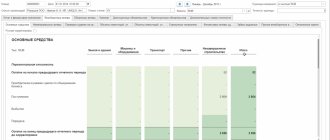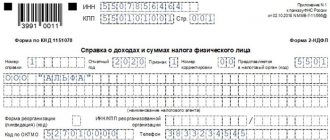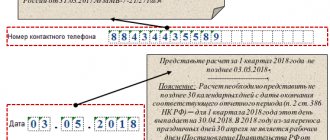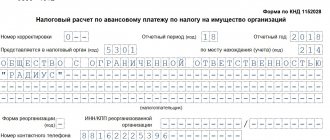The main changes that will follow in connection with the introduction of the concept of residual value of intangible assets are the amount of income tax. This is important when calculating payments to the budget. And if earlier accountants were able to take into account only the cost of fixed assets when calculating this fee, now they can also take into account intangible assets.
Federal Law No. 374-FZ of November 23, 2021 introduced corresponding changes to the Tax Code of the Russian Federation. In particular, a procedure was established for the formation of the residual value of intangible assets by analogy with similar rules already in force for fixed assets.
Subscribe to the magazine “Calculation” or “Calculation. Premium" for the 1st half of 2021!
What are intangible assets
Intangible assets (intangible assets) differ from others in that they do not have physical form. This category includes business reputation and various intellectual property items, for example:
- web services, computer programs, mobile applications, websites;
- books, paintings, films, music and other art objects;
- trademarks and service marks;
- secret recipes and production technologies, so-called know-how;
- inventions, industrial designs, utility models;
- new varieties of plants or breeds of animals that are bred independently.
Personnel are not an intangible asset. This is stated in paragraph 4 of PBU 14/2007. It is also noted that the costs of opening or reorganizing a company are also not intangible assets.
What assets of an enterprise can be called intangible?
The company's intangible assets (IMA) are characterized by the following:
- objects have no material structure;
- it is possible to distinguish such assets from other property of the company;
- Intangible assets are used in the production process or during the provision of various services;
- bring financial profit to the owner;
- the owner does not intend to sell the assets.
Important: objects can be classified as intangible assets only when they bring benefit (profit) to the organization for more than 12 months.
Depreciation for intangible assets is also required to be charged, as for the company's tangible property. The received amount is generated and then reflected in account 05.
Conditions for accepting an asset for accounting as intangible
To accept an object for accounting as an intangible asset, you need to make sure that seven conditions are met in relation to it:
- An asset has the potential to generate money in the future.
- The organization has the right to receive income from this object, and other persons do not have access to the economic benefits from it. That is, the company must have patents, certificates, agreements on the alienation of exclusive rights or other documents.
- An asset can be separated or separated from other assets.
- The asset will be used for longer than 12 months or the operating cycle if it is longer than 12 months.
- The entity does not intend to sell the asset within the next 12 months or operating cycle.
- The original cost of an asset can be reliably determined.
- The asset has no tangible form.
If any of the conditions are not met, it will not be possible to take the asset into account as an intangible asset. In such cases, its value can be included in R&D expenses, deferred expenses or current expenses.
Depreciation calculation
Depreciation for each intangible item must be calculated monthly. In this case, accruals must begin in the month following the month the intangible asset was put into operation.
Example Fregat LLC bought and registered the exclusive right to a special invention; this fact was confirmed by a special patent. On February 26, the agreement on the alienation of exclusive rights was registered with Rospatent, and the intangible asset itself was accepted for accounting and, accordingly, put into operation. Amortization of this intangible asset should be calculated and accrued starting from March of the current year. Let us recall that in accounting there are three methods for calculating depreciation of intangible assets: linear, the reducing balance method and the method of writing off value in proportion to the volume of production or work. Whereas in tax accounting there are only two methods: linear and nonlinear.
Note that when using each of these methods, depreciation of intangible assets must be calculated based on its service life. The latter, in turn, is determined based on the validity period of a patent, certificate, license to use exclusive rights or other documents (for example, a contract) confirming the company’s right to a given intangible asset.
The residual value of fixed assets and intangible assets is determined as the difference between their original cost and the amount of depreciation accrued over the period of operation (clause 1 of Article 257 of the Tax Code of the Russian Federation).
Which accounts should I use to record intangible assets?
The main account for accounting for intangible assets is 04. It collects information about what intangible assets the organization has, their receipt and sale, as well as the company’s expenses on R&D. Account 04 is active, therefore the receipt of intangible assets is reflected as a debit, and the disposal as a credit.
The procedure for accounting for intangible assets is similar to that for fixed assets. Before entering the debit of account 04, the asset and all costs of obtaining it are taken into account in account 08 “Investments in non-current assets”.
To calculate depreciation on intangible assets, account 05 is used - depreciation is reflected on the loan. From January 1, 2008, it is no longer possible to charge depreciation on the credit of account 04, thereby reducing the initial cost of intangible assets.
The procedure for reflecting depreciation on account 05
Depreciation amounts are credited to account 05 at certain regular intervals. Much depends on which depreciation method was chosen. In debit there are cost accounts that illustrate the volume of expenses of a production or sales nature.
When an intangible asset is disposed of, the depreciation amount that has already been formed on account 05 is written off to the credit of account 04. The final write-off is carried out at the residual value.
Account 05 analytics is always carried out for each individual asset. This is necessary so that the depreciation amount is calculated taking into account the useful life of the production unit.
The need for account 05 is due to the fact that any property has its own service life. The further you go, the less effective this or that object will be in operation. The loss of functionality is documented, gradually leading to depreciation and then write-off of the asset.
Accounting for the acquisition or creation of intangible assets
The treatment of an asset depends on how it was received. Intangible assets can be produced independently, purchased, or received free of charge. In any case, an asset must be taken into account at its original cost - the amount of actual costs for its purchase or creation.
Firms that have the right to simplified accounting may include the costs of purchasing or creating intangible assets as expenses as they are incurred and not be reflected as part of intangible assets.
Purchase of intangible assets. The initial cost may include payments under the contract, fees for specialist consultations on the purchase of the asset, registration fees, taxes that cannot be reimbursed, and other expenses directly related to the acquisition. The wiring is as follows:
- We take into account the costs of acquiring the asset (excluding VAT) - Dt 08 Kt 60, 76.
- We take into account VAT on the amount of costs - Dt 19 Kt 60, 76.
- We register the asset - Dt 04 Kt 08.
- We reflect the tax deduction for VAT - Dt 68-VAT Kt 19.
Purchasing the right to use. For intangible assets for which the organization purchased only the right to use, a slightly different procedure is provided. This also applies to various accounting programs or legal reference systems. Record such assets on an off-balance sheet account at the value specified in the agreement. Attribute regular payments for use to expenses of the reporting period, and if you make a one-time payment, consider it as an expense for future periods and write it off as expenses while the contract is valid. The wiring is as follows:
- We take into account the cost of the received asset - Dt 012.
- We reflect the payment for obtaining the right of use (excluding VAT) - Dt 97 Kt 60.
- We take into account VAT under the contract - Dt 19 Kt 60.
- We accept VAT for deduction - DT 68-VAT Kt 19.
- Each month we include in the expenses of the reporting period a part of the total payment taken into account in the expenses of the future period - Dt 20 Kt 97.
- When the term of the contract for use ends, we write off the cost of intangible assets - Kt 012.
Free receipt. If you are given an asset as a gift, it must be valued at market value. It is determined on the date of acceptance for accounting. The wiring is as follows:
- We reflect the market value of intangible assets - Dt 08 Kt 98.
- We accept the asset for accounting - Dt 04 Kt 08.
Creation of intangible assets. If you created an asset yourself, take it into account at its cost, which includes all the costs of its creation and registration. This will include expenses for employee salaries, insurance premiums, equipment rental, examinations, duties, registration, and assistance from third-party organizations in creating an asset. You can accept the asset for accounting after you receive a patent. The wiring is as follows:
- We collect all production costs on account 08 - Dt 08 Kt 70, 69, 76, 60.
- We accept the asset for accounting - Dt 04 Kt 08.
Accounting for the transfer of intangible assets
You will be able to sell your intangible asset to another organization, individual entrepreneur or individual. To do this, they transfer the exclusive right to the object by concluding an alienation agreement. Another option is to transfer only the right to use the asset.
Sale of intangible assets. To sell an object, enter into an agreement on the alienation of ownership, draw up an invoice and an acceptance certificate. Also, the transfer of rights sometimes needs to be registered.
Recognize income from the sale of intangible assets as other income and reflect it in accounting on the date of signing the agreement or registering the transfer of rights, if required.
Make the following entries:
- We reflect income from the transfer of exclusive rights - Dt 62 Kt 91-1;
- We charge VAT (if the transfer is taxed) - Dt 91-2 Kt 68-VAT;
- We write off depreciation on the transferred asset - Dt 05 Kt 04.
- We attribute the residual value of intangible assets to expenses - Dt 91-2 Kt 04.
- We take into account the duty and other sales costs - Dt 91-2 Kt 76.
Transfer of the right of use. In this case, the buyer of the right of use will regularly transfer royalties to you. Since the asset remains your property (you have the exclusive right), you cannot write it off the balance sheet and stop accruing depreciation. The wiring is as follows:
- We reflect the received license payments in other income or sales income - Dt 62 Kt 90-1 or 91-1.
- We continue to charge depreciation. If the transfer of use rights is your main activity, write off depreciation as expenses for ordinary activities Dt 20 (23, 25, 44) Kt 05, if not the main one, as other expenses - Dt 91-2 Kt 05.
Depreciation of intangible assets
If an intangible asset has a useful life (SPI), then it gradually transfers its value to costs in the form of depreciation. You must determine the deadline at the stage of accepting the asset for accounting. This could be the period during which you will have exclusive rights, the planned period of use, or the period during which you want to produce the volume of the goods for which you purchased the intangible assets.
The SPI must be reviewed annually. If it changes, then the depreciation calculation is adjusted. In accounting, adjustments are reflected as changes in estimated values and are recognized in income and expenses prospectively.
If SPI cannot be determined, depreciation may not be charged. But in this case, all the factors that prevent you from knowing the deadline must be indicated in the explanations for the accounting reports
Depreciation is calculated starting from the month following the month in which the asset is taken into account. Accrual stops only from the month following the one in which the cost of the intangible asset was fully repaid or it was written off from the balance sheet.
The posting for depreciation depends on how the depreciable intangible asset is used:
- if we use it in our main activity - Dt 20 (23, 25, 44) Kt 05.
- if we use it for the production, reconstruction and modernization of other assets - Dt 08 Kt 05.
- if we use it in other types of activities - Dt 91-2 Kt 05.
Record the depreciation calculation in the depreciation sheet.
Accrue depreciation in accordance with the method chosen and approved in the accounting policy. There are three in total to choose from:
- Linear is the simplest method with equal payments. It is chosen when it is difficult to estimate future income from intangible assets. Depreciation per month = Initial (current) cost / SPI (month)
- Declining Balance - With this method, the annual depreciation will gradually decrease. It is chosen for those assets that generate the greatest income at the beginning of use. Depreciation per month = Residual value at the beginning of the month × Coefficient (you set it yourself, up to 3) × Remaining SPI (month)
- Proportional to volume of production - depreciation depends on the degree of use of the asset, but the calculation is labor-intensive. This method is not suitable for calculating income tax. Depreciation per month = Actual volume of products produced per month using this intangible asset × Initial cost / Expected volume of production for the entire SPI.
Reflection in accounting
Let's look at the basic accounting entries that will be needed to reflect intangible assets in accounting.
Acquisition of intangible assets
- Debit 08 “Investments in non-current assets” Credit 60 “Settlements with suppliers and contractors”
- acceptance of intangible assets for accounting;
- VAT on the purchased object;
- payment to the supplier by bank transfer (or cash);
- VAT creditable;
- commissioning of intangible assets.
Amortization of an intangible asset
- Debit 20, 23, 44 (according to cost accounting accounts) Credit 04, 05 (depending on the method determined by the accounting policy)
- monthly reflection of depreciation of intangible assets.
Write-off of an intangible asset
- Debit 05 “Amortization of intangible assets” Credit 04 “Intangible assets”
- the amount of accumulated depreciation of intangible assets is reflected;
- the residual value of the intangible asset is written off (if any);
- loss on disposal is reflected.
Implementation of intangible assets
- Debit 05 “Amortization of intangible assets” Credit 04 “Intangible assets”
- accumulated wear and tear;
- the residual value is shown (if available);
- the buyer's debt has formed;
- VAT on sales is reflected;
- payment has been received from the buyer.
Stay up to date with the latest changes in accounting and taxation! Subscribe to Our news in Yandex Zen!
Subscribe
Balance sheet
In the balance sheet, intangible assets are reflected in line 1110 of the “Non-current assets” section. To calculate the correct figure for the line, you need to find out the residual value of assets - take the balance according to Dt 04 and subtract from it the balance according to Kt 05. This is due to the fact that the balance is compiled in a net valuation, that is, minus depreciation and other regulatory values.
Note! Line 1130 is not suitable for accounting for intangible assets. It is intended for intangible exploration assets, the accounting rules of which are regulated by PBU 24/2011. These include rights to exploration and evaluation of deposits, exploration results, etc.
Keep records of intangible assets using the Kontur.Accounting service. Draw up documents, calculate depreciation, accept assets for accounting and write them off the balance sheet. And in the accounting department you can prepare reports and submit them to regulatory authorities via the Internet. All new users receive 14 days of free use of the service.






